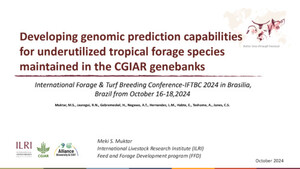
Dynamics of animal performance, and estimation of carbon footprint of two breeding herds grazing native neotropical savannas in eastern Colombia
Abstract
The savannas of eastern Colombia located in the Orinoco river basin represent 18% of the Latin American neotropical savannas, and those areas that are tillable and closer to markets are subject to considerable anthropic pressure in the quest for intensification. Historically, and even today, beef cattle production constitutes the main land use, and much of it is subjected to extensive management. This paper describes for the first time, the use of cattle grazing experiments to assess methane (CH4) emissions from neotropical savanna-based beef breeding systems, and with the support of published research conducted next to them, estimates of the carbon (C) footprint in carbon dioxide equivalents (CO2-eq) for the whole system. Over 5 years and covering complete reproductive cycles, a conventional weaning (CW) herd system was compared to an early weaning (EW) herd system, that represented a modest degree of more intensive savanna management. Differences were found between the two management practices in total CH4 emissions, emission intensities [kg CH4 kg –1 calf born and kg CH4 kg –1 liveweight gain (LWG)] and emission efficiencies (kg CO2-eq kg –1 calf born and kg CH4 kg –1 LWG), that mostly associated with the different lactation lengths. When both herd systems were carried over until calves, later yearlings, reached to 25 months of age, the differences in favor of EW breeding herd system were diminished. The calculated C footprint in (CO2-eq) of both management practices was near neutral subjected to a number of assumptions and the use of limited published information on savanna C stocks and CH4 and nitrous oxide (N2O) emissions from soil, and it is posited that both herd systems were nearly in equilibrium. The available data and results show the need for further information on the neotropical savanna C stocks and C sequestration potential of soils of the Orinoco river basin. More reliable datasets regarding below-ground C inputs and CH4 and N2O emissions from soil are needed to provide a useful basal benchmark for, and approach to, future analyses of environmental impact of more intensive beef herd systems in the region.
Citation
Ramírez-Restrepo, Carlos A.; Vera, Raul R.; Rao, Idupulapati M. 2019. Dynamics of animal performance, and estimation of carbon footprint of two breeding herds grazing native neotropical savannas in eastern Colombia. Agriculture, Ecosystems & Environment, 281: 35-46.









